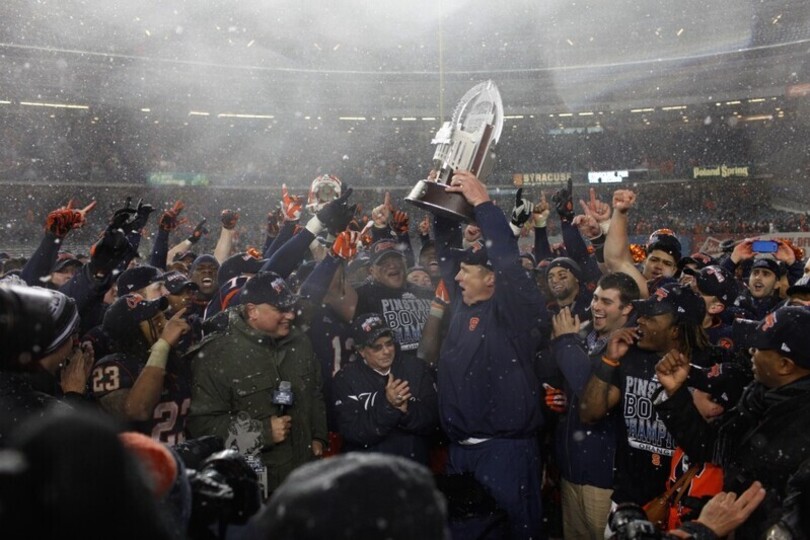In 2012, SU sent off Doug Marrone with a win over West Virginia at Pinstripe Bowl

Syracuse took down West Virginia in the Pinstripe Bowl 10 years ago, capping off a rollercoaster 8-5 season 2012 Pinstripe Visuals | Daily Orange File Photos)
To support student journalism and the content you love, become a member of The Daily Orange today.
A bowl game, let alone a winning record, seemed out of reach in 2012.
The Orange dropped their opening game against Northwestern before losing by 13 to USC and falling on the road to Minnesota. Syracuse started the season 1-3, and there were rumblings about head coach Doug Marrone’s job security, said former offensive lineman Sean Hickey.
But down the stretch, the team turned the nose up on what began as a flailing season. Catalyzed by a 30-point blowout of UConn to finish 7-5, SU earned a spot in the 2012 Pinstripe Bowl against West Virginia.
“It went all the way from him being on the hot seat to (Marrone) having NFL head coaching offers,” Hickey said.
“A couple factors” led to one of the most dominant wins of Syracuse’s season, said former offensive lineman Zack Chibane. A massive snowstorm moved into the area. Temperatures at Columbia University’s Baker Athletics Complex, where Syracuse practiced, hovered just below 30 degrees, while the storm moved West Virginia’s practice inside at the team hotel’s ballroom.
“A lot of times, we don’t play in this weather,” Ryan Nassib said to reporters in 2012.
West Virginia, led by now-Seahawks quarterback Geno Smith, was a high-powered offense that averaged the 13th-most points per game in the country.
“We were feeling rejuvenated and recharged,” Chibane said. “The game plan was to run the ball, and we had a lot of experience with West Virginia’s defense and their front six.”
The 2012 Pinstripe Bowl was a way to send off a talented crop of seniors — many of whom went to the NFL — after a rollercoaster of a season. It turned out to be the last time Marrone and the majority of his staff would be at the helm of Syracuse. West Virginia’s flashy offense couldn’t adjust, while Syracuse totalled 369 rushing yards to cement a 38-14 win over the Mountaineers.

Stephanie Zaso | Digital Design Director
The Orange came in “pretty confident,” said former wide receiver Alec Lemon. The accolades — co-Big East champions and a 6-1 finish after starting 2-4 — thrusted Syracuse into its second Pinstripe Bowl in three years. West Virginia had just moved to the Big 12 for that season. Everyone knew everyone. Syracuse and West Virginia were a Big East rivalry that had reigned over the region since 1991.
WVU head coach Dana Holgorsen said drawing a rival instead of a new opponent for the bowl game “made his job a little easier.” He said he pulled tape from the last two seasons to watch rematches take place, both of which ended with upset victories for the Orange. The rivalry and the bad taste of the Mountaineers falling two-straight times to the Orange fueled each team heading into the matchup.
“We knew their defense pretty well. Our defense always gave Geno fits,” Hickey said. “Coach (Scott) Shafer always had a good game plan for him, and we were able to do the same thing in the game.”
Chibane said there wasn’t a break after SU’s week five bye, leading to nine-straight games, including a one-possession loss to then-No. 19 Rutgers and a nine-point loss to Cincinnati. But the three weeks between Syracuse’s final regular season game and the Pinstripe Bowl allowed the team to heal. The offensive line, Chibane said, could finally lift weights for strength instead of to quell soft tissue injuries. He said the line was at full strength for a ground attack that ultimately punished West Virginia.
“They had a lot of (defensive backs) on the field, not the biggest guys out there,” Lemon said. “We felt that our line and our running backs, the way that they’d been rolling, that we could run the ball at will. And that’s what we did.”
Chibane said playing at Yankee Stadium was “surreal.” Lemon was assigned C.C. Sabathia’s locker, right next to Derek Jeter’s. The history and magnitude of what some refer to as the best team in sports, can sometimes be disorienting to wide-eyed college football players entering into a field with new external dimensions, Lemon said. One corner of the end zone was nearly blocked off by a massive snow mound that was shoveled off the field.
Entering the game, Syracuse knew West Virginia couldn’t win sloppy games. The Orange’s defense had also shut down Smith each of the last two years. Additionally, WVU’s defense had allowed at least 38 points in seven-straight games during the middle of the season, a streak that continued in the Pinstripe Bowl.
West Virginia utilized the 3-3-5 defense, one that featured three-down defensive linemen and linebackers. SU knew not every offensive lineman would be lined up across from a defender, which allowed the line to burst toward the second level and create a five-yard hole for either Prince-Tyson Gulley or Jerome Smith to run through. Hickey said the Orange took advantage of the scheme, and estimated they ran split flow inside zone between 25 and 30 times.

Stephanie Zaso | Digital Design Director
“We just ran the ball down their throat. It was pretty self explanatory,” Hickey said.
The Orange mustered a field goal in the first quarter, the game’s sole score, before heading to halftime up 12-7. Then, lifted by Gulley and Smith, Syracuse bludgeoned West Virginia in the third to the tune of 23 points, giving it a firm lead in an eventual 24-point victory, its second-largest win of the season.
There were rumblings that it would be Marrone’s last game as head coach before he hoisted the Pinstripe Bowl trophy, but the Orange went home for a two-week break with no word on his decision.
Then, a few days before New Year’s Eve, right as players were settling in at home, news broke that Marrone would leave to become the next head coach of the Buffalo Bills, Hickey said.
“I think he knew, once that game was over, that he was going to be gone,” Hickey said.
It was the last ride for Marrone — his 25th win with the Orange, the last game Syracuse would play as a member of the Big East. The Orange had once again packed Yankee Stadium, despite both 2012 and 2010 featuring cold, blizzard-like conditions. It’s a testament, Chibane said, to how well Syracuse does as a university in New York City, and to how beloved the football team is.
“We wanted to win the Big East, (and go to) a bowl game,” Lemon said. “As we’re sitting there with a trophy passing it around, hugging everybody, and just knowing that we’ve accomplished what we wanted to do.”





